Vines With Red Flowers (With Pictures and Names) – Identification

Red flowering vines are climbing or creeper plants that add stunning red, scarlet, or dark pink colors to a garden landscape. Vines with red flowers require little maintenance, but their effect in a yard is spectacular. You can grow red climbing plants over arbors and pergolas or up trellises and brick walls. The attractive red flowers contrasting against lush green foliage enhance any garden.
Many climbing perennials have red flowers that come back every year. Evergreen vines such as coral honeysuckle keep their leaves all year and blossom with red flowers in summer. Other red climbing garden vines such as red mandevilla, red-flowering cypress vine, or red climbing fuchsia vines bloom all summer long with showy red flowers. Annual trailing plants with red flowers such as the red cardinal creeping vine require planting every year.
This article is a guide to the most stunning red climbing plants and creeper plants you can grow in your garden. Descriptions and pictures of red flowering vines will help you choose suitable climbing plants for your garden.
Where to Plant Flowering Vines
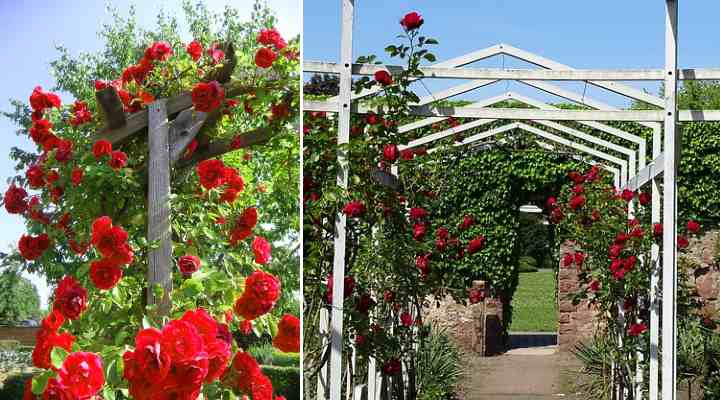
Flowering climbing plants are a great addition to any garden landscape
Climbing plants with red flowers are ideal for growing in full sun to partial shade. The lush green foliage and red blossoms look spectacular growing up a wall or trellis, over a pergola or arbor, or to create privacy along a fence. Some red climbing plants will grow up structures without support, whereas creeper plants need training and support.
Typically, flowering vines grow well in most soil types. Usually, climbing flowering plants grow best in moist, well-draining soil. During summers, flowering vining plants growing in full sunshine require frequent watering to keep the ground moist.
Types of Vines for Your Garden or Yard
Your choice of flowering vines for your garden or yard depends on the effect you want to achieve. Types of vines fall into two categories—climbers or creepers.
Climbing vines have roots or suckers that attach to surfaces and climb without much intervention. You’ll often find clinging vines or climbers naturally growing up trees, brick walls, house facades, and wooden structures.
Some climbers are tendril vines with small shoots that cling onto surfaces. These climbing plants are ideal for covering chain-link fences, growing up arbors, pergolas, or trellises.
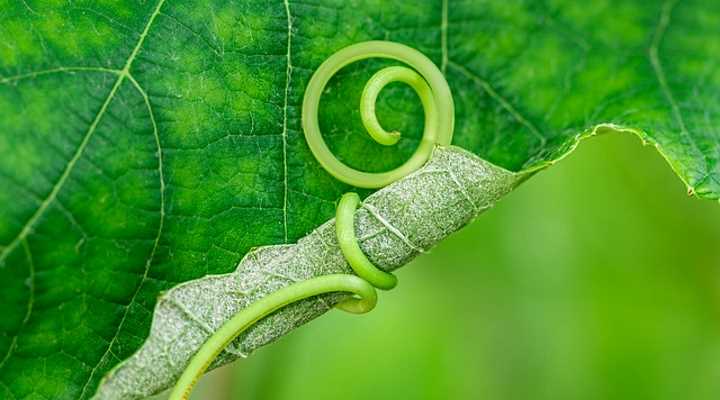
A close up picture of tendril grapevine
Creeper vining plants are trailing vines that need help to grow upward. You can grow creeper plants as ground cover plants or train them to grow up trellises. Creeping plants with twining vines require that you wrap or intertwine the red flowering stems through trellises or arbors.
The Best Vines with Red Flowers (With Pictures)
Let’s look in more detail at stunning examples of vining plants with beautiful red flowers. For each climbing plant, you’ll find detailed information about where to grow the vines in your garden landscape.
Red Mandevilla Vine (Rocktrumpet)

Mandevilla is a flowering vine with beautiful red trumpet-shaped flowers that thrives in full sun and warm areas
Red Mandevilla is a tropical flowering, climbing, evergreen vine with fragrant red trumpet-shaped flowers. The beautiful tropical vine thrives in full sun and warm weather. Mandevilla climbing vines grow between 6 and 10 ft. (1.8 – 3 m) tall. You can train the climbing plant’s twining vines to grow against a wall, trellis, or arbor.
The funnel-like flowers earn the red vining Mandevilla the common name rocktrumpet. The scented red flowers grow up to 4” (10 cm) across. The beauty of this vine plant is the eye-catching clusters of up to 20 red flowers growing along the long stems.
It’s easy to train red Mandevilla vines to wrap around poles, trees, or mailboxes. You can also create a living privacy screen by allowing the twining vines to grow up a fence. The semi-evergreen oval leaves create lush, leafy foliage throughout most of the year.
Species of flowering Mandevilla vines belong to the family Apocynaceae. For this vine to grow outdoor and flower, it must grow in USDA zones 10 or 11.
Red-Flowering Cypress Vine (Ipomoea quamoclit)
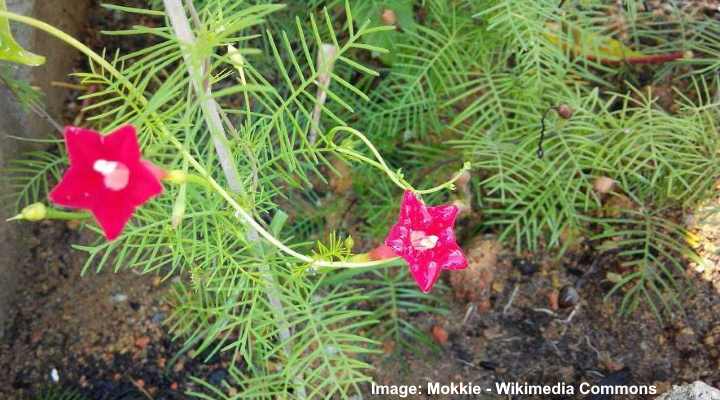
Cypress vine has small pretty star-shaped red flowers and grows as an annual climber in warmer climates
The red-flowering cypress vine is a fast-growing, annual climbing plant with twining vines and small scarlet red star-shaped, tubular flowers. Native to tropical climates, the flowering cypress vine quickly grows between 15 and 20 ft. (4.5 – 6 m) high. As an annual vine, the tropical plant thrives in full sun in USDA zones 11 and 12.
The red-flowering cypress also goes by the name cypress hummingbird vine. The common names of this morning glory (Ipomoea) plant come from the way hummingbirds and nectar-feeding insects are attracted by its bright red flowers. Also, the leaves are light and feathery, like some species of cypress plants.
The cypress climber vine attaches to structures with twining stems. Its star-shaped red flowers look spectacular, covering pergolas, lattice fences, deck posts, and arbors.
Although the red-flowering cypress vine grows as an annual, it has the characteristics of a perennial vine. In warm, tropical climates, the seeds drop to the ground. This means the flowering vine comes back year after year to fill your garden with colorful red flowers during summer and fall.
Red Climbing Fuchsia Vine
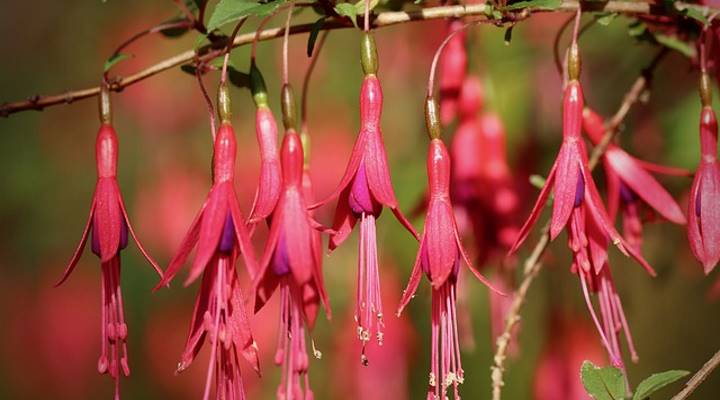
Fuchsia is a fast growing climber with attractive flowers in various shades of red, pink and purple
Many fuchsia cultivars are shrubby climbing vines with deep pink, crimson, or bright red flowers. In bloom from spring until the fall, the vigorous climbing vine is a mass of dangling red, bell-shaped flowers. The fuchsia vine leaves are dark green, ovate with serrated margins.
Climbing fuchsia plants grow up to 5 ft. (1.5 m) in a single season and reach a mature height of 10 ft. (3 m). Hardy fuchsias grow well in USDA zones 9 through 11.
The decorative vining fuchsia plants are ideal for back-of-border plantings in partial shade or full sun. The red vining plants also work well covering trellises, chain-link fences, or as a flowering privacy screen. You can also grow species of fuchsias as a flowering hanging basket plant.
Red Cardinal Climber Vine (Ipomoea × multifida)

The decorative red flowers of cardinal climber vine cover beautifully arbors or pergolas
The red cardinal climber vine is an annual plant with tubular red flowers that grow up to 2” (5 cm) long. The cardinal climber attaches to trellises, arbors, walls, or fences via twining stems. During summer and fall, masses of trumpet-shaped flowers cover the green triangular, lobed leaves.
Red cardinal climbing vines flower best in full to partial sun. The scarlet red flowers each have five petals creating a star shape. The showy flowers grow in clusters of two to five flowers, creating a stunning floral display.
When growing without support, red cardinal vines can grow as dense ground cover for full sun. Other ways to grow red cardinal climber vines include climbing over arbors, trellises, or other structures. You can also use the plant as a back-of-border planting to grow up a lattice frame.
Red Morning Glory (Ipomoea coccinea)
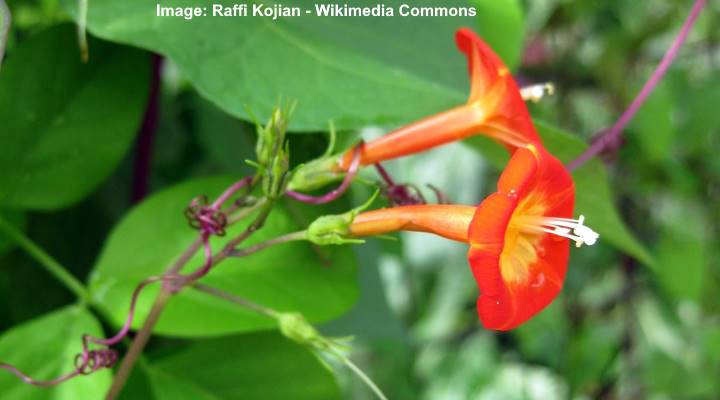
Red morning glory is an annual fast growing climbing plant that is tender perennial in warmer climates
Red morning glory is an annual climbing vine with bright red or orange-red flowers that bloom throughout the summer until frost. As a fast-growing flowering vine, the plant quickly grows to around 10 ft. (3 m) high. The spectacular red flowers are tube-like trumpet flowers that grow up to 2” (5 cm) long.
Like most morning glory vines, the fragrant flowers grow in small clusters of up to 12 flowers. The clusters of red flowers contrast with large green, three-lobed leaves that are 2” to 4” (5 – 10 cm) wide.
Other names for red morning glory climbing vines include redstar, scarlet creeper, and Mexican morning glory.
Red Firecracker Vine (Ipomoea lobata)
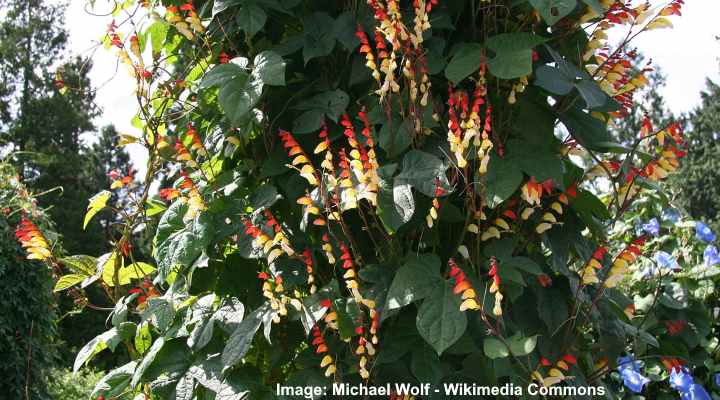
Firecracker vine has ornamental flowers in various shades of yellow, orange and red that look stunning when climbing on arbors or trellises
The red firecracker is a climbing perennial or annual red-flowering vine with stunning flower spikes and large lobed leaves. The rapidly growing vine grows between 13 ft. and 26 ft. (4 – 8 m) tall. The deeply lobed leaves are 2 to 6” (5 – 15 cm) long, and the tiny red tubular flowers grow on 6” (15 cm) long spikes.
Red firecracker vines get their name from the appearance of the blooms. The tiny tube-like flowers grow from yellow to red and look like firecrackers. Also, the yellow and red flowers earn the vine the other common name—Spanish flag vine.
Red firecracker vines grow as perennials in USDA zones 10 and 11. You can grow the tall, climbing vines in temperate climates as annuals, where they may reach a height of 10 – 16 ft. (3 – 5 m) in a season.
Red Bougainvillea Vine

Bougainvillea is a flowering climbing plant that comes in various colors and thrives in full sun
Red bougainvillea is a spectacular low maintenance perennial vine that produces masses of bright red, showy, fragrant flowers. The red flowering vine blooms are on show for most of the summer. The clusters of small tubular flowers measure around 1” (2.5 cm). The heart-shaped leaves measure 5” (13 cm) and 2.3” (6 cm) wide.
Bougainvillea woody vines with their stunning red flowers grow between 15 and 40 ft. (4.5 – 12 m). In USDA zones 9 through 11, the vines are evergreen if there is rainfall all year; otherwise, the leaves drop in the dry season.
Red bougainvillea is a beautiful climbing vine with a spreading nature. You can grow the red flowering vine as a privacy hedge, tall accent plant, to cover walls, or grow over entrance-ways. The vine’s spiky thorns also mean that the spreading vine is an ideal security hedge.
Red Clematis Vine

Clematis is a common easy to grow climbing plant in many gardens with various shades of flowers including red
Red clematis is a hardy perennial climbing vine with showy red flowers and heart-shaped or triangular leaves. Depending on the clematis type, the flowers can be in the shape of a star, trumpet, or cross. Each velvety red flower has four to eight petals. Red clematis vines mature between 6 and 12 ft. (1.8 – 4 m) tall.
Clematis woody vines thrive in full sun and moist, well-drained soil. The shrubby climbing vine grows in USDA zones 3 through 9.
Other names for clematis plants include vase vine, leatherflower, traveler’s joy, and old man’s beard.
Clematis vines are ideal for growing up a wall, fence, arbor, or deck post. The tendrils on the vines attach to structures, making this climbing vine easy to care for and grow. Alternatively, you can grow clematis as a colorful, fast-growing ground cover plant.
Red Trumpet Creeper Vine (Campsis radicans)
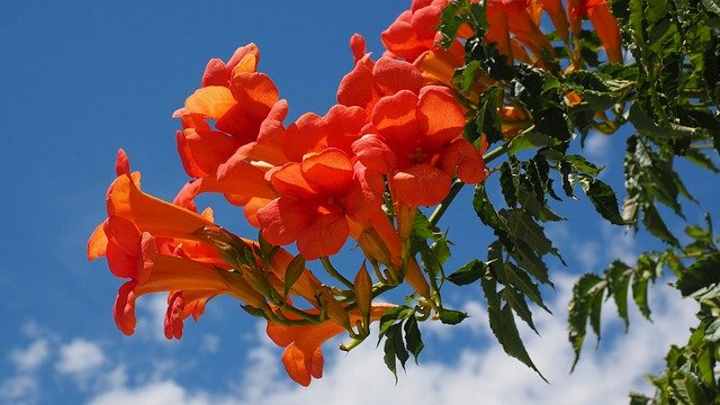
Red trumpet is a fast growing creeper vine that can be invasive
Red trumpet vine is a creeper plant with large, funnel-shaped flowers growing in dangling clusters from the vine. Each cluster can have four to 12 orangey-red, showy trumpet flowers. The deciduous vining plant is a fast-growing creeper that grows up to 33 ft. (10 m) long.
Red trumpet woody vines also go by the names cow vine, devil’s shoestring, trumpet creeper, or hellvine.
Red trumpet vines have tendrils that attach to almost any surface. The vigorous vine grows well on arbors, trees, fences, and telephone poles. In some areas, trumpet vines are invasive vining plants requiring heavy pruning to control their growth.
Scarlet Trumpet Vine (Distictis buccinatoria)
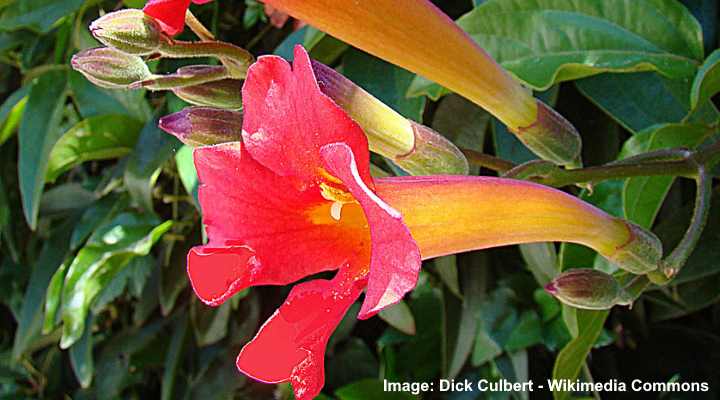
You can grow scarlet trumpet vine in full sun to part shade in well-draining soil
Scarlet trumpet vine is a fast-growing evergreen hardy climbing vine that creates a floral display of deep red, trumpet-shaped flowers. This vigorous garden vine grows best in USDA zones 9 through 11. The dark red flowers grow up to 3” (8 cm) long. The climbing stems grow rapidly and reach heights of between 40 and 50 ft. (12 – 15 m).
Coral Honeysuckle Vine (Lonicera sempervirens)

Coral honeysuckle is a vigorous climbing plant with red flowers that grows best in full sun but can tolerate part shade
Coral honeysuckle is a native vining plant with pretty, red tubular flowers dangling in clusters. As a fast-growing twining plant, coral honeysuckle grows between 10 and 20 ft. (3 – 6 m) high and up to 6 ft. (1.8 m) wide. The soft evergreen ovate leaves are 1” to 3” (2.5 – 7.5 cm) long.
The attractive feature of coral honeysuckle climbers is the showy flowers. The flowers consist of four or five petals that are 3” (7.5 cm) long. The vine’s flower colors are bright red to orange-red. You can expect coral honeysuckles to bloom from early spring until late summer. This is one of the showiest vining honeysuckles for covering fences, arbors, or pergolas.
Because it’s a native vine, coral honeysuckle is a non-invasive vining plant. So, it’s good not to mistake it with the invasive vine—the red Japanese honeysuckle (Lonicera japonica). The invasive Japanese honeysuckle vine will quickly choke out other plants as its twining vines take over gardens.
Red Iochroma Vine (Iochroma fuchsioides)

While red Iochroma vine prefers full sun, it benefits from partial shade in warmer climates
Red Iochroma is a perennial vine that blooms with a profusion of tube-like red flowers. The bushy spreading plant’s flowers grow in large clusters and contrast with the large green, ovate leaves. The beautiful vining red flowering shrub grows up 4 ft. (1.2 m) tall and wide. The stunning plant is hardy in USDA zones 8 through 11.
Red Climbing Roses
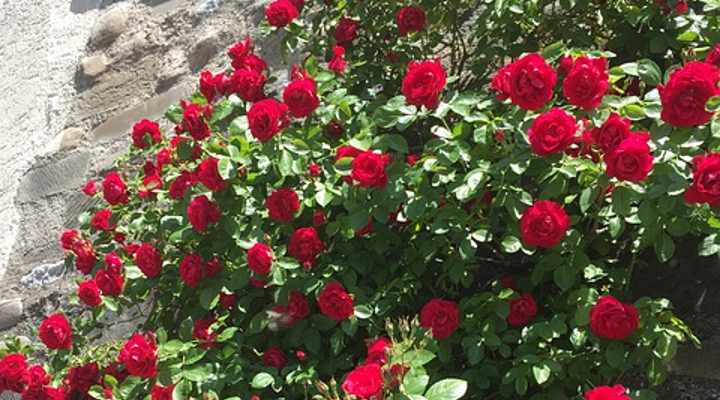
There are beautiful varieties of rose hybrids and cultivars to use as garden climbers
Climbing roses with red flowers grow like woody flowering vines. The tall flowering shrubs can fill your garden with color and scent like no other flower. Tall climbing roses come in dark red, burgundy, white and red, blood red, and dark pink colors. Some of the most outstanding beautiful climbing roses grow between 6 and 14 ft. (1.8 – 4.2 m) tall.
Climbing roses aren’t vines that naturally cling to walls and trellises. They don’t have tendrils or suckers like climbing vines. It’s necessary to attach the long woody stems to structures to get the roses to climb arbors, pergolas, and lattice frames.
To grow climbing roses, plant the beautiful flowering shrubs in rich but well-draining soil and full sun. Like all rose varieties, the plants need regular feeding to grow and bloom profusely.
Crossvine (Bignonia capreolata)
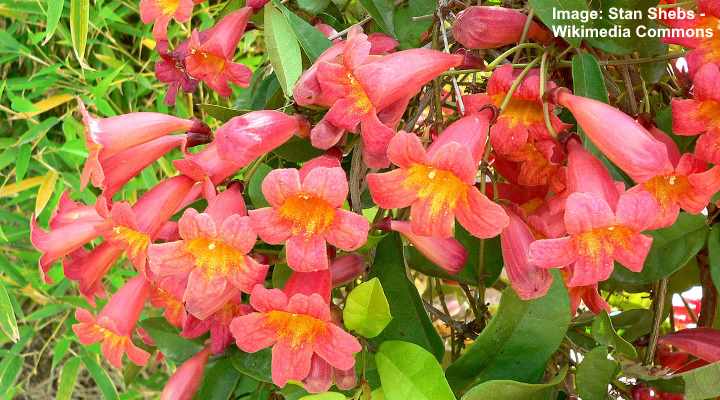
Crossvine is a fast growing low-maintenance climber that can grow very tall
Crossvine is a spectacular climbing woody vine that blooms with masses of orange-red trumpet-shaped flowers. The flowering climber uses tendrils to attach to trellises, fences, or tree bark to climb. The funnel-shaped flowers grow in small clusters, and individual flowers measure 2” (5 cm) long.
Crossvine is a deciduous, cold-hardy vine that has lanceolate leaves that grow up to 6” (15 cm) long and turn gold, purple, or red in the fall. However, in warmer regions, crossvine is a perennial broadleaf, evergreen, fast-growing vine.
The clinging stems of crossvine plants can reach enormous heights. The twining vines can grow between 30 and 50 ft. (9 – 15 m).
Crossvine thrives in USDA zones 5 through 9. However, in zone 5, the vine usually dies back to the ground in winter, and the hardy perennial vine starts growing again in spring.
This easy to grow vine is an excellent choice to add beautiful red, orangey colors to gardens in temperate and sub-tropical climates. Grow crossvine over pergolas or arbors, up trellises, poles, trees, and fences. Crossvine is also an excellent creeper plant for floral, evergreen ground cover.
Related articles:
